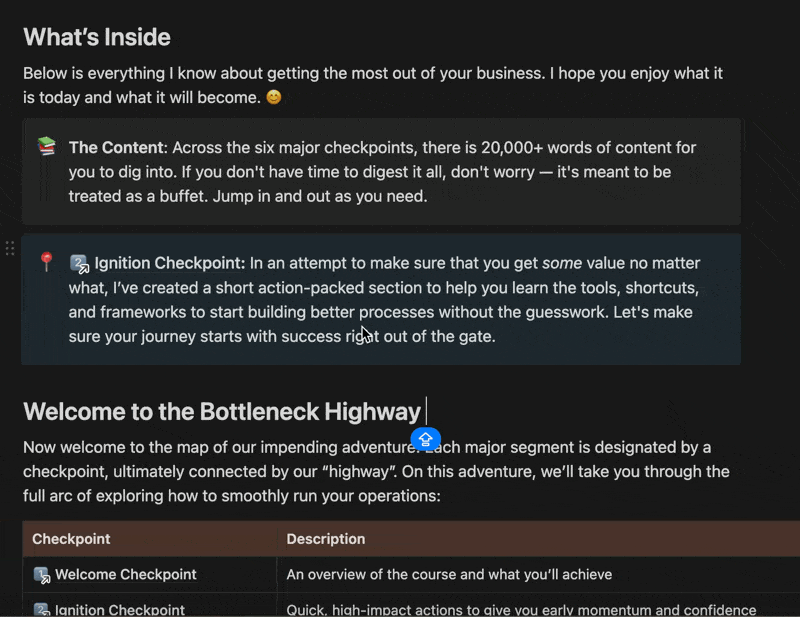Not subscribed? Sign up to get it in your inbox every week.

⚙ Hi {{first_name_tally|Operator}},
I don’t regret any fun debauchery I had in my 20’s. I definitely don’t regret leaving bad situations. But I do regret every witty comeback I never made at work.
What’s a comeback that you wished you could’ve said but didnt?
- Rameel
P.S Facing a problem at work? Let’s jam! Here is my cal link

PRESENTED BY THE BOTTLENECK
Ready to leap from “reliable doer” to the ops leader everyone counts on?
Your calendar is full. Your brain is fried. And somehow, your work still flies under the radar.
Here’s the truth: You don’t get promoted for working more. You get promoted for thinking like an executive.
Bottleneck Breakers is the system I used to:
– Trim 20 hours of busywork a week
– Fix the stuff that actually moved the needle
– And earn a COO title before I turned 30
🧠 No video lectures. Just drop-in systems that make you undeniable when promotion season hits.
PRESENTED BY FRAMER
Design and ship your dream site with Framer. Zero code, maximum speed.
Just publish it with Framer. Beautiful sites without code — easily. Join thousands of designers and teams using Framer to turn ideas into high-performing websites, fast. The internet is your canvas.
Thanks to our sponsors who keep this email free. Interested in sponsoring these emails? See our partnership options here

Developing compliance simulation drills
Insight from LinkedIn
Listen, I know you’re doing your best to comply with every regulation applicable, but it’s not always smooth sailing.
A little misunderstanding in the law or some late papers can cause small compliance problems. If your team isn’t prepared to handle those situations, that’s when you need to panic because those teeny problems become something bigger.
And the best way to prepare everyone for what’s bound to happen eventually is through simulation. A study has found that employees learn 20% better with simulation training as compared to other learning methods.

But how can you develop a compliance simulation so engaging and so life-like, that your team is actually pushed to their limits to solve the problem… without the risk?
As I see it, if Monopoly can get families to scream at each other over fake money, you can certainly make compliance engaging enough to get employees invested. Gamify your drills:
Points for Performance: Award points for quick thinking, correct actions, and problem-solving. Make a leaderboard. People love leaderboards (even if they won’t admit it).
Escape Room Style Challenges: Lock the solution to your compliance crisis behind puzzles or tasks that require collaboration. Bonus: this weeds out lone-wolf operators who think they’re above the system.
Role Reversals: Let the intern play the inspector for once. Watching them wield imaginary authority is worth it alone—but it also teaches the team to handle pressure from unexpected sources.
These are just a few samples of what you can do, but in reality, compliance simulation drills can be as fun, serious, or wild as you want it to be. What shouldn’t be missing from these drills are emotions.
When emotions are involved, that’s where the human element comes in. Put your team’s emotional resilience to the test by simulating high-pressure interactions.
Start with the angry customer drill. One team member plays the irate customer demanding immediate answers while the rest of the team handles compliance processes under fire.
Once they’ve recovered from that, throw in a media nightmare simulation—a reporter (complete with a microphone) asking tough questions about a supposed compliance breach.
End with a group dynamic meltdown—split the team, give conflicting instructions, and see if they can maintain effective communication under chaos. Spoiler alert: they probably can’t at first, but that’s why we practice.
Compliance drills shouldn’t feel like rehearsals—they should feel like real crises unfolding in real-time.
That’s why the next step is to inject unpredictability and controlled chaos into the mix. Start with unannounced inspections. No hints, no preparation—just a sudden compliance audit that forces your team to respond as they would in the wild.
Because at the end of the day, compliance problems often come out of the blue.
Then, crank up the stakes with planted problems. Introduce intentional errors or compliance gaps and watch how your team handles them. Do they catch the issues early, or do they unravel under pressure? Throw in misinformation—false reports, conflicting instructions, or missing data—and see who can stay calm and untangle the mess.
The goal here isn’t perfection—it’s resilience. The team that adapts instead of freezes wins the day.






